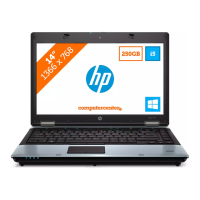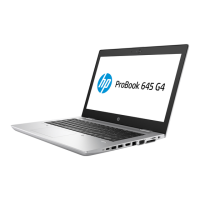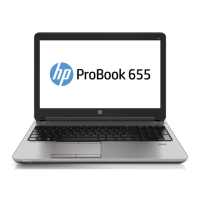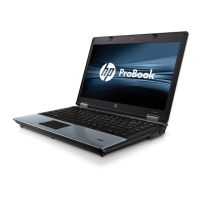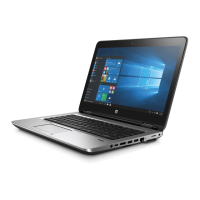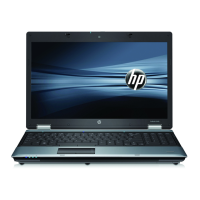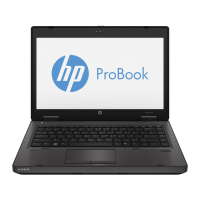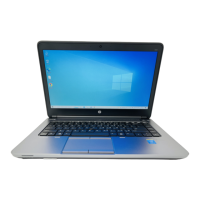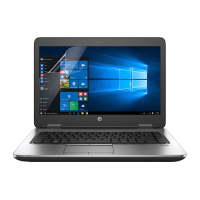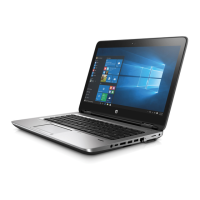Do you have a question about the HP ProBook 6455b and is the answer not in the manual?
Details the various AMD and Intel processors available for the HP ProBook models.
Lists the chipsets and graphics solutions supported by the HP ProBook series.
Describes the different display panel options, including size, resolution, and features.
Details the memory module types, capacities, and configurations supported.
Lists supported hard drive and solid-state drive capacities and features.
Identifies and describes the various external ports and connectors on the laptop.
Describes the keyboard layout, pointing stick, and touchpad functionalities.
Lists security options like cable slots, TPM, and fingerprint reader availability.
Details the preinstalled operating systems available with the computer models.
Explains how to view installed hardware using Device Manager in Windows.
Details components located on the top of the laptop, like cameras, microphones, and antennas.
Explains the function of various keys on the keyboard, including function and special keys.
Describes the functionality of the pointing stick and touchpad for cursor control and selection.
Details the purpose of function buttons and the fingerprint reader for system interaction.
Explains the meaning of various indicator lights on the computer for status information.
Identifies components located on the front of the laptop, such as lights and latches.
Lists and describes ports and slots on the right side of the laptop.
Identifies ports and vents on the left side of the laptop.
Details ports and connectors found on the back of the laptop.
Describes components located on the underside of the laptop, like battery and vents.
Explains the information found on the service tag for identification and support.
Provides a breakdown of major internal computer components with their part numbers.
Lists and details spare parts for the display assembly, including bezels and panels.
Lists specifications and spare part numbers for hard drives and solid-state drives.
A comprehensive list of spare parts organized by their sequential part numbers.
Outlines necessary tools, considerations, and precautions before performing component replacements.
Explains electrostatic discharge (ESD) and precautions to prevent component damage during handling.
Detailed steps for safely removing and installing the laptop battery.
Procedures for removing and replacing hard drives and solid-state drives.
Steps for removing and installing RAM modules.
Detailed instructions for removing and installing the laptop keyboard.
Detailed procedures for removing and installing the main system board.
Guide to accessing and using the Computer Setup utility within Windows 7.
Instructions for accessing and navigating the Computer Setup utility in Windows Vista.
Guide to using the Computer Setup utility for Windows XP systems.
Explains options available in the File menu of the Computer Setup utility.
Describes settings for boot options and device configurations in Computer Setup.
Provides physical dimensions, weight, and environmental operating conditions for the laptop models.
Technical details of the 15.6-inch display, including resolution and viewing angle.
Details specifications for various hard drive capacities, including seek times and rotational speed.
Explains how to use Windows 7 Backup and Restore for data protection and system recovery.
Details methods for recovering files and the system using built-in tools or recovery discs.
Instructions for backing up and restoring data on SUSE Linux SLED 11.
Pinout details for the IEEE 1394 (FireWire) port.
Pinout details for the RJ-45 network port.
Pinout details for the USB ports.
General requirements for power cord sets, including length, approval, and current capacity.
Country-specific requirements and agency approvals for power cord sets.
Guidelines for proper disposal of used computer batteries.
Information on handling and recycling display components, including mercury warnings.
Details the various AMD and Intel processors available for the HP ProBook models.
Lists the chipsets and graphics solutions supported by the HP ProBook series.
Describes the different display panel options, including size, resolution, and features.
Details the memory module types, capacities, and configurations supported.
Lists supported hard drive and solid-state drive capacities and features.
Identifies and describes the various external ports and connectors on the laptop.
Describes the keyboard layout, pointing stick, and touchpad functionalities.
Lists security options like cable slots, TPM, and fingerprint reader availability.
Details the preinstalled operating systems available with the computer models.
Explains how to view installed hardware using Device Manager in Windows.
Details components located on the top of the laptop, like cameras, microphones, and antennas.
Explains the function of various keys on the keyboard, including function and special keys.
Describes the functionality of the pointing stick and touchpad for cursor control and selection.
Details the purpose of function buttons and the fingerprint reader for system interaction.
Explains the meaning of various indicator lights on the computer for status information.
Identifies components located on the front of the laptop, such as lights and latches.
Lists and describes ports and slots on the right side of the laptop.
Identifies ports and vents on the left side of the laptop.
Details ports and connectors found on the back of the laptop.
Describes components located on the underside of the laptop, like battery and vents.
Explains the information found on the service tag for identification and support.
Provides a breakdown of major internal computer components with their part numbers.
Lists and details spare parts for the display assembly, including bezels and panels.
Lists specifications and spare part numbers for hard drives and solid-state drives.
A comprehensive list of spare parts organized by their sequential part numbers.
Outlines necessary tools, considerations, and precautions before performing component replacements.
Explains electrostatic discharge (ESD) and precautions to prevent component damage during handling.
Detailed steps for safely removing and installing the laptop battery.
Procedures for removing and replacing hard drives and solid-state drives.
Steps for removing and installing RAM modules.
Detailed instructions for removing and installing the laptop keyboard.
Detailed procedures for removing and installing the main system board.
Guide to accessing and using the Computer Setup utility within Windows 7.
Instructions for accessing and navigating the Computer Setup utility in Windows Vista.
Guide to using the Computer Setup utility for Windows XP systems.
Explains options available in the File menu of the Computer Setup utility.
Describes settings for boot options and device configurations in Computer Setup.
Provides physical dimensions, weight, and environmental operating conditions for the laptop models.
Technical details of the 15.6-inch display, including resolution and viewing angle.
Details specifications for various hard drive capacities, including seek times and rotational speed.
Explains how to use Windows 7 Backup and Restore for data protection and system recovery.
Details methods for recovering files and the system using built-in tools or recovery discs.
Instructions for backing up and restoring data on SUSE Linux SLED 11.
Pinout details for the IEEE 1394 (FireWire) port.
Pinout details for the RJ-45 network port.
Pinout details for the USB ports.
General requirements for power cord sets, including length, approval, and current capacity.
Country-specific requirements and agency approvals for power cord sets.
Guidelines for proper disposal of used computer batteries.
Information on handling and recycling display components, including mercury warnings.
| Graphics | ATI Mobility Radeon HD 4250 |
|---|---|
| Chipset | AMD M880G |
| Processor | AMD Phenom II |
| Display | 14.0-inch diagonal LED-backlit HD anti-glare (1366 x 768) |
| Memory | Up to 8 GB DDR3 |
| Storage | 128 GB Solid State Drive |
| Optical Drive | DVD+/-RW SuperMulti DL |
| Ports | 3 USB 2.0 |
| Battery | 6-cell lithium-ion |
| Operating System | Windows 7 Professional |
| Wireless | Bluetooth |
| Audio | High Definition Audio, stereo speakers, stereo headphone/line out, stereo microphone in |
| Card Reader | 5-in-1 card reader |
| Webcam | 2 MP Webcam |
